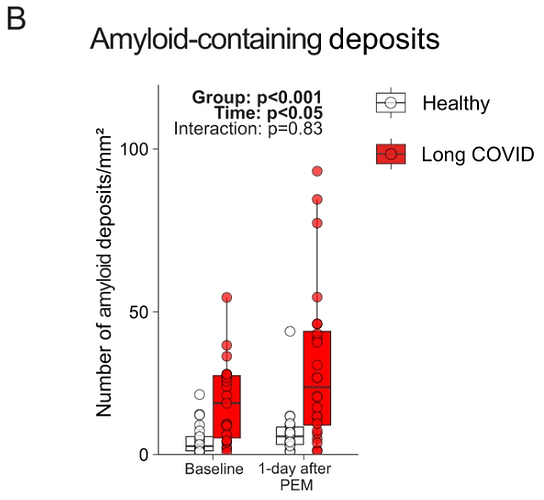Appelman and colleagues conducted a study funded by PLRC and several other groups. Because it’s PLRC, they looked into the microclots and viral persistance hypotheses. They did not find evidence to support either. The research doesn’t debunk those theories but didn’t find evidence to support certain versions of those theories.
They did find that some Long COVID patients were more likely to have amyloid-containing deposits (‘microclots’) before exercise and after exercise. So that’s what the researchers mean by “Muscle abnormalities worsen after” exercise.
It doesn’t seem to affect all Long COVID patients though. While interesting, it doesn’t seem like it will lead to an explanation of all Long COVID.
There’s a Twitter thread/summary by one of the researchers but it’s a little misleading just like the paper’s abstract. The abstract is misleading because it suggests that they’ve made findings that help us understand post-exertional malaise. However, the researchers don’t actually claim to have figured out the cause of post-exertional malaise.
This study highlights novel pathways that help to understand the pathophysiology of post-exertional malaise in patients suffering from long COVID and other post-infectious diseases.
The abstract also uses language that seems to pander to the PLRC as it uses certain phrases that I’ve bolded. The data from the study doesn’t support the use of those phrases, e.g. because they didn’t study people with other “post-infectious diseases”. The phrase “post-exertional malaise” is abused because their control group doesn’t experience PEM but did experience exercise. The correct title for the paper should be Muscle abnormalities worsen after exercise in long COVID. What they found in the Long COVID group was also happening in the control group so they should use the word exercise instead of PEM.
Microclots
Here is what the paper says about one version of the microclot hypothesis:
[deposit = amyloid-containing deposit]
Therefore, we conclude that post-exertional malaise cannot be explained by the hypothesis that these deposits block vessel perfusion, causing local tissue hypoxia
Viral Persistence
Our results suggest that the presence of residual SARS-CoV-2 nucleocapsid protein is similar between patients and healthy controls, and therefore does not explain the limited exercise capacity or development of post-exertional malaise in patients with long COVID.
The bottom line
Misleading abstract. The main finding is that the original hypothesis were NOT supported by their study’s data. But because people like research funding, they don’t say that and instead say that their study found interesting things.
Here’s the paper:
https://www.nature.com/articles/s41467-023-44432-3
